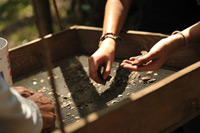Projects
The Sarabay Project
After the UNF Archaeology Lab first discovered the lost indigenous village of Sarabay in 2020, UNF is now excavating broad areas in search of activity areas, houses and other buildings. The Mocama-speaking Timucua Indians of northeastern Florida were among the first indigenous populations of Florida encountered by European explorers in the 1560s. Documents written by the French and Spanish describe Timucua villages and hint at the locations. While the actual whereabouts of most of these villages had gone undetected for nearly 450 years, testing by the UNF Archaeology Lab has identified the archaeological location of the village of Sarabay at the Armellino site on Big Talbot Island, Florida.
The UNF Archaeology Lab is undertaking one of the most intensive and extensive excavations at a Timucua village in the state of Florida, through the current implementation of a four-year field project. During 2020-23 field seasons, UNF is conducting archaeological excavations at the Armellino site on Big Talbot Island and excavating broad areas in search of activity areas, houses and other buildings associated with the village. The project will provide a solid database for sixteenth-century Timucua settlements and allow students and volunteers the opportunity to touch the ancient past of northeastern Florida. This project is part of UNF’s larger Mocama Archaeological Project that began in the 1990’s.
The Search for La Caroline
 One of the most iconic features of the modern Jacksonville landscape is Fort Caroline. This National Park Service (NPS) Memorial honors the first French settlement (La Caroline) in North America (1564-1565). Following its downfall at the hands of the Spanish, the fort became the scene of a Spanish garrison known as San Mateo (1565-1569). Although today’s replica of Fort Caroline receives thousands of visitors a year, currently not one shred of material evidence has been found relating to the French colony of La Caroline or the later Spanish fort. Colonial documents concerning the forts, however, do exist and point to its location within the broader Ft. Caroline area of modern Jacksonville. With the 450th anniversary of the founding of Fort Caroline just around the corner (2014), we have initiated a systematic archaeological search for evidence of these two historic landmarks.
One of the most iconic features of the modern Jacksonville landscape is Fort Caroline. This National Park Service (NPS) Memorial honors the first French settlement (La Caroline) in North America (1564-1565). Following its downfall at the hands of the Spanish, the fort became the scene of a Spanish garrison known as San Mateo (1565-1569). Although today’s replica of Fort Caroline receives thousands of visitors a year, currently not one shred of material evidence has been found relating to the French colony of La Caroline or the later Spanish fort. Colonial documents concerning the forts, however, do exist and point to its location within the broader Ft. Caroline area of modern Jacksonville. With the 450th anniversary of the founding of Fort Caroline just around the corner (2014), we have initiated a systematic archaeological search for evidence of these two historic landmarks.
Mill Cove Complex
Our research at the Mill Cove Complex along the south side of the St. Johns River shows that the fisher-hunter-gatherers who lived in the Jacksonville 1000 years ago were actively involved in long distance exchange networks that ushered in exotic copper, galena, mica, stone, and other minerals from far-flung areas of eastern North America. Most notably we have evidence of direct connections between local natives and Cahokia along the Mississippi River near modern-day St. Louis.
Mocama Archaeological Project
This long-term, problem-oriented study focuses on the Mocama-speaking Timucua Indians who lived along the Atlantic coast of northern Florida at the time on European arrival (A.D. 1562). The project combines archaeological survey, excavation, laboratory analysis, and archival research. It is committed to the search for Mocama villages in an effort to reconstruct the 16th century social landscape of northeastern Florida. Beyond locating villages and exploring their physical layouts, the project is designed to research the social history and culture of the region’s 16th and 17th century Native Americans in the face of European contact, colonization, and missionization.
Mission Santa Cruz de Guadalquini
We have spent the past several seasons excavating the relocated Spanish mission of Santa Cruz de Guadalquini. Beyond the great artifacts and features we have uncovered, the most interesting aspect about this site is that it was occupied for only 12 years (1684-1696). This affords us the opportunity to examine Indian life during a brief window in time. In fact, it was occupied during a turbulent time in the history of Atlantic coastal Spanish missions, one marked by the threat of French piracy and British-backed slave raiding. We have uncovered gun flints and tobacco pipes which show contact with the British Carolina colony.
